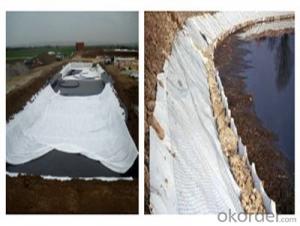100% Polyester Filament Woven Geotextile Manufacturers in China
- Loading Port:
- China main port
- Payment Terms:
- TT OR LC
- Min Order Qty:
- 5000 m²
- Supply Capability:
- 1000000 m²/month
OKorder Service Pledge
OKorder Financial Service
You Might Also Like
Specification

1.100g/m2-800g/m2
2.4m-7m in roll width ,the length as clients’ request
Packaging & Shipping
Packing: PLASTIC FILM INSIDE, AND WOVEN BAG OUTSIDE
Shipping: About 15 days after receipt the deposit
geotextile fabric
permeability,filtration,easy for construction
ISO and CE certificate
Good quality and competitive price
Our Service
Quality assurance
1.On a regular basis or as per your request,we entrust national testing agencies to conduct quality inspections
2. Strictly in accordance with the ISO9001-2008 international quality system standard,we monitor and manage the whole process throughout production,quality testing,and measurement to ensure product quality
3. For quality-related construction delay or substandard construction(except for damage or losses due to customer’s responsibility or irresistible natural disasters),we have refunding,replacement,and repair services.We will respond to customers’ feedbacks on quality issues within 24 hours.
FAQ:
Q: What kind of payments does jenor support?
A: T/T, L/C, Cash are accepted.
Q: Do you charge for the samples?
A: Accordeing to our company policy, the samples are free, we only charge the freight fee. And we will return the freight fee during the next order.
Q: Can you produce according to customers' design?
A: Sure, we are professional manufacturer, OEM and ODM are both welcome.
Q: Do you have other products?
A: Yes, please check the pictures:
- Q: Can geotextiles be used in the construction of wastewater treatment plants?
- Yes, geotextiles can indeed be used in the construction of wastewater treatment plants. Geotextiles are commonly used in these projects for various purposes such as filtration, separation, erosion control, and reinforcement. They can be applied in different areas including lining of ponds, filtration of effluent, protection of pipes, and stabilization of soil. Geotextiles help enhance the efficiency and longevity of wastewater treatment plants by providing necessary support and functionality.
- Q: How do geotextiles help with soil reinforcement in embankments?
- Geotextiles help with soil reinforcement in embankments by providing a stable and strong layer that prevents soil erosion, improves load distribution, and enhances the overall stability of the embankment.
- Q: Are geotextiles resistant to earthquakes?
- No, geotextiles are not inherently resistant to earthquakes. They are primarily used for erosion control, soil stabilization, and filtration purposes. While they can provide some reinforcement to the soil, their main function is not to withstand seismic activity.
- Q: How do geotextiles help with reinforcement of geotextile bags?
- Geotextiles help with the reinforcement of geotextile bags by providing strength and stability to the bags. They act as a barrier and prevent the soil or other fill material from escaping through the pores of the bags. Additionally, the geotextiles distribute the weight of the fill material evenly, reducing the risk of bulging or bursting of the bags.
- Q: What are the key considerations for geotextile installation in cold climates?
- There are several key considerations for geotextile installation in cold climates. First, it is important to choose a geotextile material that is specifically designed for cold weather conditions. This ensures that the material will not become brittle or easily damaged in freezing temperatures. Additionally, proper site preparation is crucial, including removing snow and ice from the installation area to ensure a stable base for the geotextile. It is also important to properly anchor the geotextile to prevent shifting or movement due to freeze-thaw cycles. Overall, careful selection of materials and proper installation techniques are essential for successful geotextile installation in cold climates.
- Q: what do you mean nonwoven geotextiles ???
- please refer the folowing url to know all the details about non woven geo textiles
- Q: What are the applications of geotextiles in landscaping?
- Geotextiles have several applications in landscaping, including erosion control, soil stabilization, and weed suppression. They are commonly used to prevent soil erosion on slopes by providing a stable base for plants and preventing the loss of topsoil. Geotextiles also help to stabilize the soil by distributing the weight of heavy objects, such as rocks or pavers, and preventing them from sinking into the ground. Additionally, they can be used as a barrier to prevent weed growth, reducing the need for herbicides and manual weeding.
- Q: What is the difference between woven and non-woven geotextiles?
- Woven geotextiles are made by interlacing yarns or fibers together in a regular pattern, creating a strong and durable fabric. Non-woven geotextiles, on the other hand, are manufactured by bonding or felting fibers together, forming a random web-like structure. This results in a fabric that is less strong but offers excellent filtration and drainage properties. In summary, woven geotextiles are stronger and more suitable for applications requiring high tensile strength, while non-woven geotextiles are ideal for filtration and drainage purposes.
- Q: Basement roof cover soil thickness and geotextile shop in what position,
- The basement roof to do waterproof, covered with drainage board, and then laying in the drainage board geotextile, and then cover the geotextile 80 cm of soil. Huazhi geotextile material manufacturers
- Q: Are geotextiles suitable for use in canal lining?
- Yes, geotextiles are suitable for use in canal lining. They offer excellent filtration, erosion control, and separation capabilities, preventing soil erosion and enhancing the stability and longevity of the canal lining. Additionally, geotextiles can help with water drainage and resist degradation from exposure to UV rays and chemicals commonly found in canal environments.
Send your message to us
100% Polyester Filament Woven Geotextile Manufacturers in China
- Loading Port:
- China main port
- Payment Terms:
- TT OR LC
- Min Order Qty:
- 5000 m²
- Supply Capability:
- 1000000 m²/month
OKorder Service Pledge
OKorder Financial Service
Similar products
Hot products
Hot Searches
Related keywords






























